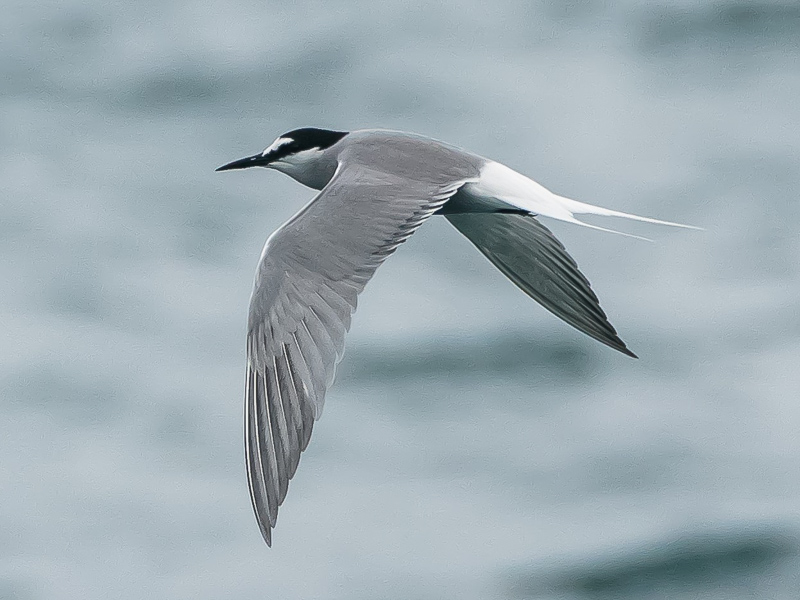Aleutian Tern Onychoprion aleuticus 白腰燕鷗
Category I. Uncommon passage migrant in spring and autumn to sea areas.
IDENTIFICATION

May 2017, Michelle and Peter Wong.
32-38 cm. The bill is relatively fine and pointed and the lower edge of the distal half of the lower mandible can be seen to angle upwards on good views. Adult in breeding plumage has rather dark grey upperparts, a grey wash to the underparts, white rump and tail and broad white forehead surrounded by black from mid-crown to hind neck and from bill to eye.
Adults in non-breeding plumage have white underparts and white among the black hind crown feathers. First-winter birds have brown-tinged dark areas on the head, dull greyish upperparts with diffuse paler fringes and darker leading edge to the inner wing.

Apr. 2021, Kenneth Lam.
Diagnostic in all plumages are the dark tips to the secondaries on the underwing, sometimes also visible on the upperwing. Wing beats are slower and deeper than those of Common Tern.

Sep. 2008, Michelle and Peter Wong.
In juvenile plumage the mantle, scapulars and tertials are dark grey-brown with clean cut whitish fringes and the primaries are paler with diffuse dark fringes.

Oct. 2022, Paul Leader.
Juveniles in flight show obvious contrast between dark grey-brown mantle, scapulars and lesser coverts and pale greyish flight feathers. The dark trailing edge to the secondaries remains distinctive.
VOCALISATIONS
Calls are high-pitched and wader-like, different from those of other terns in Hong Kong.
DISTRIBUTION & HABITAT PREFERENCE
All records have occurred at sea, mainly in southern waters, either from ferries (often to and from Po Toi) or dedicated seabird survey trips or during the close approach of tropical storms. Aleutian Terns appear to be particularly susceptible to the influence of the latter and frequently appear at traditional sea-watching localities such as Cape D’Aguilar. Inshore and inland records have occurred during the passage of tropical storms. Examples are a total of 31 birds at Pui O, Lam Tsuen and Tso Wo Hang (Sai Kung) on 23 August 2017 and three in Tolo Harbour on 10 September 2002.
OCCURRENCE
The first record for HK occurred on 22 August 1992 when scattered small groups and individuals totalling at least 190 birds were found between Cheung Chau and Lamma (Kennerley et al. 1993). Aleutian Terns have since been found to be regular passage migrants in both spring and autumn (Figure 1).
The earliest spring date is 1 April 2012 while the latest is 7 June 1993. The earliest autumn record is of two in southern waters on 11 August 2019, while the latest concerns four juveniles in eastern waters on 25 October 2007.
The highest numbers occurred during the passage of a tropical storm over 1-2 May 1999 when 1,483 (618 on 1st and 865 on 2nd) were recorded at Cape D’Aguilar. Other notable counts have included 430 off Po Toi on 9 September 2010 (the highest autumn count) and a single flock of 250 there on 14 May 2013.
BEHAVIOUR, FORAGING & DIET
As with other terns, frequently seen on flotsam.
RANGE & SYSTEMATICS
Monotypic. Breeds in northeast Asia and Alaska on Sakhalin and nearby areas, the Kamchatka peninsula and its vicinity, the Aleutian Islands and southwest Alaskan coastal areas; probably winters in the western Pacific as there are non-breeding season records from Singapore, Borneo and Indonesia (North 2020). In China rare in coastal areas on passage (Liu and Chen 2021).
CONSERVATION STATUS
IUCN: VULNERABLE. Population decreasing rapidly at Alaskan breeding colonies; probably undergoing rapid declines over three generations due to habitat modification, predation, egg harvesting and human disturbance.
Figure 1.

Kennerley, P. R., P. J. Leader and M. R. Leven (1993). Aleutian Tern: the first records for Hong Kong. Hong Kong Bird Report 1992: 107-113.
Liu, Y. and S. H. Chen (eds) (2021). The CNG Field Guide to the Birds of China (in Chinese). Hunan Science and Technology Publication House, Changsha.
North, M. R. (2020). Aleutian Tern (Onychoprion aleuticus), version 1.0. In Birds of the World (S. M. Billerman, Editor). Cornell Lab of Ornithology, Ithaca, NY, USA. https://doi.org/10.2173/bow.aleter1.01

